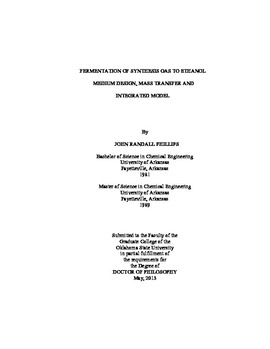| dc.contributor.advisor | Atiyeh, Hasan K. | |
| dc.contributor.author | Phillips, John Randall | |
| dc.date.accessioned | 2018-04-23T19:35:59Z | |
| dc.date.available | 2018-04-23T19:35:59Z | |
| dc.date.issued | 2013-05 | |
| dc.identifier.uri | https://hdl.handle.net/11244/299539 | |
| dc.description.abstract | The U.S. Energy Information Administration projects ethanol as the most prominent biofuel through 2035. The need for biofuels is driven by increased national security, rural development, meeting transportation fuel requirements, improving the environment and sustainability. Currently, most ethanol is derived from corn grain or sugar crops, and diverting food and allocating arable land to supply energy demand is questionable land use policy and distorts our agricultural economy. Alternative feedstocks include lignocellulosic wastes and crops grown on marginal land tapped for the captured solar energy they contain. Conversion of lignocellulosic material and other wastes to synthesis gas, also called syngas, containing CO and H2 makes this energy available for direct combustion, catalytic reforming to liquid hydrocarbons, or conversion to ethanol via fermentation by acetogenic autotrophs like Clostridium ragsdalei. Acetogenic bacteria convert syngas to ethanol in a series of elementary chemical reactions through the Wood-Ljungdahl pathway, in a simple process that proceeds at mild temperature and pressure. The fermentation exhibited more than 80% conversion of both CO and H2, which is required for energy conservation in the ethanol fuel. Syngas fermentation has commercial potential that requires demonstrated productivity, stability and economy to be realized. The economy of the fermentation process depends on medium design that delivers highly functional nutrition to the bacteria at very low cost; the function and requirement for each component supplied is considered in the method applied for medium design. As CO and H2 are only slightly soluble in aqueous medium the transfer of these gases is quantified and the effects assessed to define appropriate level of mass transfer and develop methods of control to achieve highest rates and conversions of CO and H2. Further, methods of analysis are presented that reveal the conditions of reaction at the enzyme sites inside the cell where the fermentation reactions occur. The integrated model of the fermentation simultaneously considers the mass balance, mass transfer, thermodynamics and culture kinetics in a novel concept of fermentation that is amenable to computer analysis, and essential for fermentation process design and control. | |
| dc.format | application/pdf | |
| dc.language | en_US | |
| dc.rights | Copyright is held by the author who has granted the Oklahoma State University Library the non-exclusive right to share this material in its institutional repository. Contact Digital Library Services at lib-dls@okstate.edu or 405-744-9161 for the permission policy on the use, reproduction or distribution of this material. | |
| dc.title | Fermentation of synthesis gas to ethanol: Medium design, mass transfer and integrated model | |
| dc.contributor.committeeMember | Huhnke, Raymond L. | |
| dc.contributor.committeeMember | Wilkins, Mark R. | |
| dc.contributor.committeeMember | Ramsey, Josh D. | |
| osu.filename | Phillips_okstate_0664D_12641.pdf | |
| osu.accesstype | Open Access | |
| dc.type.genre | Dissertation | |
| dc.type.material | Text | |
| thesis.degree.discipline | Biosystems Engineering | |
| thesis.degree.grantor | Oklahoma State University | |
